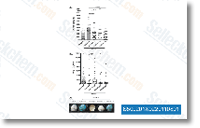In feather placode patterning, Shh and members in the Eda pathway have activator roles, while Bmp2 and Bmp4 are believed to act as inhibitors. Through mouse odontogenesis the exact same mole cules are involved in patterning the molar cusps. Attempts have been created to model cusps as outlined by activator inhibitor patterning mechanisms, having said that, whether or not indi vidual candidates is often classed as activators or inhibitors through tooth development is largely stage dependent. Molecules involved inside the establishment of vertebrate dentition have already been properly characterized from studies of your mouse. Several these molecules are recognized to have detrimental effects around the murine denti tion when removed inhibited from the dental network early in tooth development, Shh, Pitx2 and Pax9 are amongst those with serious dental phenotypes.
description For example, inhibition of Shh in mandibular explants during the transition of dental Nepicastat competence to initiation results in tooth arrest in the bud stage. Therefore, it really is clear that this gene is crucial for the correct establishment on the global dental programme. On the other hand, these studies are particular to the mouse experi mental model, which develops a single set of teeth with no replacements. We hence know practically nothing from the resulting phenotypes when modifications occur to these networks, as an example the hedgehog pathway, in verte brates with many functional tooth rows and continu ous replacement cycles. The morphogenesis of teeth, like that of other periodically patterned vertebrate organs, is regulated both by sequential and reciprocal molecular interactions among two adjacent cell layers, the epithelium as well as the straight underlying mesenchyme.
 During early stages, these distinct organs share a number of characteristics and express a familiar suite of genes with widespread roles. Quite a few studies have attempted to recognize the morphodynamic manage of iterative organization and how such patterning mecha nisms adjust throughout development to create evolution ary novelty. We sought to characterize the expression of a set of those molecules inside the dentitions of Lake Malawi cichlids to tackle an unanswered and funda mental biological question, how will be the diversity of period ically patterned elements generated in nature Malawi cichlids are exemplars of natural craniofacial diversity. In essence, all-natural selection has carried out an experiment in micro evolutionary diversification, and we want to understand how development performs to produce variation in pheno kind. The range of dental variety in Malawi is tremen dous offered a typical ancestor inside the last 500,000 to 1 million years, species possess about 10 teeth in a sin gle row, or as a lot of as 700 teeth in up to 20 rows.
During early stages, these distinct organs share a number of characteristics and express a familiar suite of genes with widespread roles. Quite a few studies have attempted to recognize the morphodynamic manage of iterative organization and how such patterning mecha nisms adjust throughout development to create evolution ary novelty. We sought to characterize the expression of a set of those molecules inside the dentitions of Lake Malawi cichlids to tackle an unanswered and funda mental biological question, how will be the diversity of period ically patterned elements generated in nature Malawi cichlids are exemplars of natural craniofacial diversity. In essence, all-natural selection has carried out an experiment in micro evolutionary diversification, and we want to understand how development performs to produce variation in pheno kind. The range of dental variety in Malawi is tremen dous offered a typical ancestor inside the last 500,000 to 1 million years, species possess about 10 teeth in a sin gle row, or as a lot of as 700 teeth in up to 20 rows.
Beta Amyloid Signal
Aβ molecules can aggregate to form flexible soluble oligomers which may exist in several forms.
